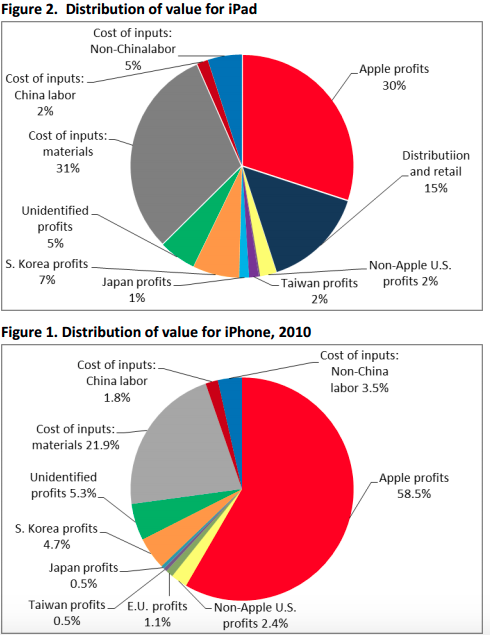Case Study: Apple, Profit and Labour Costs
14th September 2015
The Economist provides the analysis:
The chart shows a geographical breakdown of the retail price of an iPad. The main rewards go to American shareholders and workers. Apple’s profit amounts to about 30% of the sales price. Product design, software development and marketing are based in America. Add in the profits and wages of American suppliers, and distribution and retail costs, and America retains about half the total value of an iPad sold there. The next biggest gainers are South Korean firms like Samsung and LG, which provide the display and memory chips, whose profits account for 7% of an iPad’s value. The main financial benefit to China is wages paid to workers for assembling the product and for manufacturing some inputs—equivalent to only 2% of the retail price.
A student today asked why Apple doesn’t produce its products in the United States, where an economic downturn has left  14 million American out of work for the last three or four years. If iPads and iPhones were just made in America, jobs could be created, households would have more income to spend on Apple’s products, and both the country and the economy would benefit.
14 million American out of work for the last three or four years. If iPads and iPhones were just made in America, jobs could be created, households would have more income to spend on Apple’s products, and both the country and the economy would benefit.
The data in the UC study indicates that in fact, more than half the value of an iPad or iPhone does end up in the hands of Americans. But Apple could never achieve the low costs and high profits that it does by assembling its products in the US. After watching the Nightline video above, it should be clear that the type of production involved in Apple factories’ is very low-skilled and labour-intensive. Using American labor, with its unions, minimum wages and 40 hour work weeks, would require Apple to employ such large numbers of workers and raise the company’s variable cost to such a level that the firm’s profits would be reduced significantly and its sales would fall dramatically. Apple would lose out to foreign producers of smart phones and tablet computers, such as LG, Samsung, Sony and others, which would continue assembling their goods with Chinese labour.
Ultimately, any gain to the low-skilled American workers (presuming Apple could even find enough to do the work of the 400,000 Chinese employed in the production of Apple products in China), would be offset by a loss of profits enjoyed by the millions of Americans who hold shares in Apple Computer and the thousands of American who are employed engineering and designing its products, as the firm’s sales would slip in the face of lower-cost competitors.
So this student’s question identifies an interesting paradox: America, with its large pool of unemployed workers, will never be attractive as a place to produce labour-intensive products such as phones and tablet computers, due to the vast wage differential between the US and China. And even if one firm did decide to produce its products in America, the gains to low-skilled workers who may find minimum wage work in the new assembly plants would be off-set by losses to the firms’ shareholders and the high-skilled workers whose jobs would be lost as sales decline due to the lower prices offered by lower-cost competitors.
The lesson here is two-fold: First, Apple and other American technology companies should continue using Chinese labour to assemble their products, and second, America is better off for it: lower costs mean cheaper products and higher sales, thus greater employment in the high-skilled sectors of the US economy, and more profits and returns on the investments of shareholders in American corporations. Americans are richer and enjoy a higher standard of living thanks to the millions of Chinese working in factories assembling the goods we consume.
Keep in mind, this analysis did not even consider the effect on the Chinese economy and the millions of Chinese workers (whose lives are much harder than the typical American) should companies like Apple shut down their Chinese manufacturing plants.

0 Comments